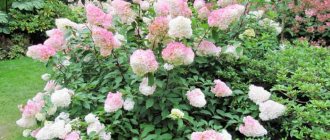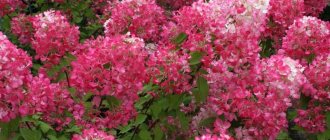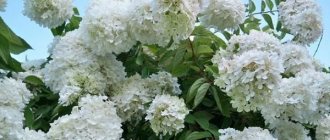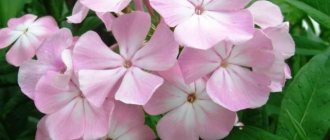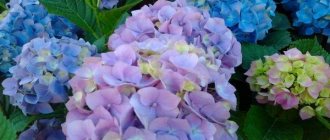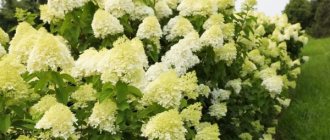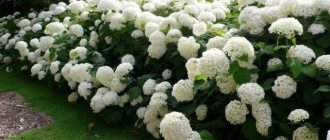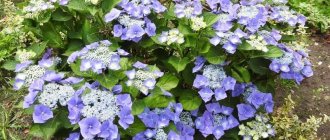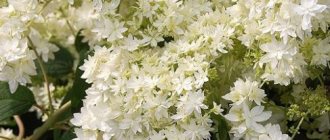Many gardeners have been growing white hydrangea for quite a long time. White hydrangea is considered a real decoration of the garden. The caps of these flowers are simply beautiful; they fascinate with their stunning appearance and unsurpassed aroma. That is why gardeners have been growing white hydrangea in their garden plots for a long time. In today’s article we will tell you about the origins of this crop, share with you a description of the variety, the secrets of propagation, planting and care rules, and at the end we will tell you how to properly prepare plants for winter and fight diseases.
About the history of the variety
White hydrangea: photo
Initially, hydrangea had only two colors: red and white, but sometimes gardeners say that there were pink and blue varieties. Breeders in many countries have worked hard to develop these varieties, so these large-leaved plants currently have a wide variety of species; the origin of the name of the crop is interesting. Currently there is more than one version.
The most famous is associated with the name of a flower in honor of a certain princess; she was so pretty that her brother named this beautiful flower after her. According to another version, hydrangea received such a beautiful name at the behest of a French doctor, namely in honor of his beautiful beloved. There is a more scientific explanation for such an interesting name for the culture. Since this plant is considered to be moisture-loving, it is also called hydrangia, which means a vessel with water. This culture is also called the purple sun; it is believed that the plant’s natural habitat is India, Japan, and America.
Paniculate hydrangeas with greenish inflorescences
The delicate green color of the petals looks incredibly touching and at the same time unusual. The most famous varieties with this color :
- Hercules;
- pearl of the festival (Perle de Festival);
- Little lime;
- Mojito;
- Magical candle;
- Skyfall.
Varieties of hydrangeas
Hydrangea is very popular among gardeners; most of all, gardeners fell in love with tree and paniculate hydrangea. The first has huge snow-white spherical inflorescences, as well as very large leaves, so it crushes the tree, but paniculate hydrangea forms inflorescences shaped like panicles, but its leaves are slightly smaller. That is why these varieties received such names. Currently, the following varieties of hydrangea varieties are very popular: Anabel, white house, sterilis, hi star best and others. But most gardeners love to grow white hydrangea, since this crop is very unpretentious, its leaves are always large, so this plant perfectly decorates any garden. Hydrangea is often planted near houses and administrative buildings. The white lady variety is interesting, as is Grandiflora. In fact, there are a lot of varieties of white hydrangea, so you are sure to find something that suits your taste.
Origin and appearance of the plant
The modern plant is distributed throughout the world. Versatile and low maintenance, it lives for 40 years and longer. The inflorescences that bloom all summer never get boring; even white varieties change color throughout their lives. From greenish, to creamy, creamy, to white and back again. What can we say about large-leaf “chameleons”, where on a bush you can simultaneously see beautiful flowers of different colors and shades.
In the garden with perennials
Description of the flower of the plant
The shrub blooms with corymbs at the ends of young or last year's shoots, small (fertile) fruiting flowers. They are located in the middle, and large (sterile) ones bloom at the edge.
Important! The plant is poisonous, as it contains hydrocyanic acid in all parts, the fruits are especially poisonous.
White hydrangea: description of varieties
White hydrangea: photo
It is believed that the birthplace of the globular white hydrangea is the United States of America. That is why the culture is considered very winter-hardy, so these plants can be grown in temperate latitudes, as well as in Siberia and the Far East. However, in severe winters the bushes sometimes freeze, so the plants should be covered. Shrubs of spherical white hydrangea are usually low, up to 2.5 m in height. The leaves are large, oval in shape, slightly ovoid, with a noticeable notch in the core and jagged edges. Leaves grow on drooping shoots, the leaves are bright green at the top, but bluish underneath.
The crown of the shrubs is also spreading and round in shape. Hydrangea inflorescences are also quite large, 25 cm long. Usually flowers form at the tips of annual shoots. Moreover, they are located on the plant very chaotically, usually at first the flowers are soft green, and then they become white, creamy, and milky. The seeds are collected in boxes, oblong and small in shape. White hydrangea begins to bloom in mid-summer and blooms very profusely, so before frost you can please yourself with the pleasant color of the inflorescences and aroma.
Combination with other plants
The peculiarity of garden hydrangea is that it goes well with both its relatives and other deciduous, flowering and even coniferous plants. These luxurious shrubs look especially harmonious with trimmed barberry, daylilies, and also with low-growing juniper. When planning a landscape design in which paniculate hydrangea will be present, you should pay attention to the viburnum-leaved vesicle, as well as purple-leaved barberries.
This luxurious plant should be planted in the background. This way it will not shade other plants, and will also act as a bright and very beautiful background. Varieties that grow as small shrubs can be planted along garden paths and as hedges.
White hydrangea: propagation
White hydrangea, like many other crops, reproduces in different ways. Namely by cuttings , by dividing the bush , by layering and by sowing seeds . If you decide to plant seeds, then this must be done at the end of winter. Hydrangea is grown through seedlings. The seeds are planted in loose and nutritious soil, the first sprouts appear in about a month and a half. When the plants are formed, they will need to be planted in separate containers. In spring, the crop is planted outside.
Many people are engaged in cuttings, for this you will need to cut the cuttings in time. In order for the root system to form more intensively, the shoots will need to be treated with rootstock, and only then planted in different containers. To take cuttings, you should choose lignified branches. Typically, cuttings take root a month after planting. If you decide to replant white hydrangea, then you can divide the bush, usually this is done in the spring, cutting the root systems into two or more parts.
Layers also take root well. In order to propagate a plant using this method, you will need to bend a young branch, preferably an annual one, to the ground and sprinkle it with nutritious soil. Do not forget to water the cuttings; when the shoots take root normally, they can be separated from the main bush, usually this is done the next year.
Species diversity
There are many varieties of this plant in the world, most of which grow in Japan and China. Fluffy spherical or paniculate inflorescences are most often white, but there are varieties with a wider color spectrum. Hydrangea bigleaf impresses with a range of colors from cream and pink shades to red.
The color is significantly affected by the pH value. In alkaline soil, hydrangea blooms with impressive pink or lilac colors. A neutral pH promotes the appearance of white or cream flowers. In acidic soil, blue and blue hydrangeas appear. By changing the acidity of the soil, you can get the desired shade.
Below are the main species and their varieties with photos and names, which are most common in gardens and impress with an incredible kaleidoscope of colors.
White hydrangea: planting
White hydrangea: photo
White hydrangea loves slightly acidic, loose and fertile soil. But it is not advisable to plant hydrangea in sandy and acidified areas. There it will grow poorly. And you should not lime the soil either, since this crop does not like wood ash. It is advisable to plant hydrangea in an area well lit by the sun and also protected from the wind. It is best to plant this crop near any buildings so that cold air does not interfere with the development of the plant. If you have a lot of free space on your site, then plant hydrangea on the east side. There it will grow intensively. In order for hydrangea to grow normally, leave two meters between plantings. Usually this crop is planted in open ground at the end of spring, in May, when the ground has warmed up considerably and the frosts have finally subsided.
Over the summer, white hydrangea has time to take root well, which means it will overwinter normally. In southern latitudes, this crop is sometimes planted in the fall, where hydrangea also grows well at this time. The planting pit will also need to be prepared in advance, about a month before the planned date of the hydrangea exhibition in open ground. It should be approximately 50 cm deep and up to half a meter wide. However, you should consider the size of the seedlings' root system. Therefore, the dimensions of the pit may also vary. Gardeners often recommend taking soil from under coniferous trees; hydrangea grows beautifully on it. Before planting a shrub, it is recommended to shorten all annual shoots by several buds. The seedling is placed in the center, the root system is well straightened and only after that the holes are filled with a fertile mixture. Don't forget to compact the soil surface and water the plants generously. For this you will need at least one bucket of water.
Sometimes gardeners immediately mulch the top layer of soil, and for this they use sawdust, dry grass, and tree bark. This helps retain moisture and get rid of weeds. If you want the seedlings to start blooming early, then they should be planted closer to each other, eighty cm apart, but after two years the plantings should be thinned out. The root collars cannot be buried; they must rise above the surface of the earth.
large-leaved
The second name for this variety is garden, since it is most common in gardens. The color of its leaves strongly depends on the pH of the soil. Particularly popular are the varieties “Endless Summer” and “Renata Stanger”, which bloom with blue and blue flowers in acidic soil. The French poet Montesquiou was so fascinated by blue hydrangeas that he called them “kings of magical worlds” in his poems.
Nikko Blue
A winter-hardy variety that can be grown both in the garden and in a pot. Large spherical inflorescences are attractive due to the wide range of colors: from snow-white to azure shades. At a neutral pH, the lightest petals appear.
Miss Saori
The most cold-resistant variety, but unlike most others, it does not respond to changes in soil acidity. Matte white flowers with a pink border are already the most attractive and delight the eye with beautiful blooms all summer long.
Endless summer
The variety attracts gardeners with its increased resistance to cold and repeated flowering. Every 6 weeks the bushes completely shed their previous flowers and produce new buds. Their color can be pink or blue. It blooms all summer, until the end of September.
Romance Pink
Large pink flowers look especially attractive. The variety is frost-resistant, but its only drawback is the short-term opportunity to admire the blooming beauty. The petals fade quickly.
Tugese
Compact bushes delight with incredibly colorful flowering. Double flowers of different colors (for example, pink and yellow) can coexist perfectly on one bush. The riot of colors makes it look like real fireworks.
White hydrangea: care
As you understand, white hydrangea is considered moisture-loving, so it is necessary to moisten the soil quite often. Every week, up to twenty liters of water are carried into the soil. It is best to use rain moisture for this. If there is excess rainfall in your region, then the crop should be watered 4-5 times during the summer. If the soil dries out, this will not have a favorable effect on the development of hydrangea. Therefore, in such conditions, the crop develops worse, and winter hardiness decreases.
To prevent plants from getting sick, experienced gardeners add a little potassium permanganate to the water for irrigation. It is best to irrigate the soil either early in the morning or late in the evening. And in order to better preserve moisture, the soil is mulched. If the autumn is also quite dry, then the crop should be watered at this time. And do not forget to loosen the soil after watering so that an earthen crust does not form.
Usually it is not recommended to feed seedlings for 2 years, but at the age of three it is recommended to add microelements to the soil; complex mineral fertilizers are suitable for this. When buds begin to form on the plant for the first time, the hydrangea should be fed with superphosphate. And at the end of summer, add a little potassium sulfate to the soil. Gardeners often water the bushes with liquid mullein, as well as chicken droppings, previously diluted in water. Sometimes the soil is fed with lactic acid. However, it is undesirable to overfeed this crop, since excess nitrogen in the soil negatively affects plant development. It is strictly forbidden to introduce wood ash into the soil.
Don't forget about pruning plants. It is better to remove unnecessary shoots in early spring, before sap begins to flow. To make shrubs bloom more abundantly, you will need to remove small buds from the bush in the first years and thin out the remaining shoots. In early spring, it is recommended to carry out sanitary pruning; sometimes old shrubs are rejuvenated by removing all diseased, old and dried branches. Shorten the shoots by about 5 buds. By radically rejuvenating the shrub, gardeners cut off all the shoots at the roots; young shoots will begin to grow in the next season.
Trimming
A special feature of caring for hydrangea is also that this shrub needs regular and proper pruning. The recommendations of experts note that this process should be carried out exclusively in the spring, some period before the start of the growing season. During the pruning process, it is necessary to remove old branches, leaving only young shoots. It should be noted that young branches also need to be shortened a little, cutting off 3-4 buds.
In autumn, pruning garden hydrangea is contraindicated. The only exceptions are those cases when it is necessary to remove fading inflorescences. It is necessary to cut off old flowers, as they feed the strength of the plant, preventing new buds from developing fully.
White hydrangea: preparation for wintering
White hydrangea: photo
Typically, plants begin to be prepared for wintering in September. Faded inflorescences will definitely need to be removed and the branches bent low to the ground. To make it more convenient for you, they can be tied. This is done so that the shoots do not break under the weight of the snow. It is recommended to cover seedlings that are too young. To do this, the root zone is covered with fallen leaves. In general, this crop is considered winter-hardy, so these plants are grown even in Siberia and the Far East. However, there it is necessary to cover the plants with fallen leaves and agricultural material. Bushes are usually covered with burlap and spruce branches. Before frost arrives, the tree trunk circle is covered with peat or compost.
After this, the shoots are pulled together and covered with some kind of breathable material. However, it is not recommended to use film for this, since moisture accumulates under it and the shoots begin to rot. In March, the shelter is removed and the mulch is also swept away, but if the frosts have not yet completely receded, then you need to wait until at least April. If certain varieties of hydrangea are not winter-hardy, they are recommended to be replanted in boxes. In this case, you will need to remove all the leaves from the bushes, and then transfer the plants to the basement.
Varieties recommended for different regions
The presented varieties of paniculate hydrangea are suitable for Russian gardens; many of them have high frost resistance and are quite unpretentious. However, when choosing a variety, it is worth considering the region and place of planting, since the resistance of varieties to growing conditions differs.
The best varieties of hydrangea for the Moscow region :
- Vanille Fraise;
- Diamond Rouge;
- Pinky Winky;
- Fantom – stable in any weather;
- Limelight – very weather-resistant inflorescences, last until frost;
- Magical Moonlight – after heavy rain, the inflorescences may fall off;
- Polar Beer – slowly developing.
Gardeners recommend pruning paniculate hydrangeas low in the fall so that the buds can overwinter under the snow.
You can form a standard. It is recommended to tie young trunks to a support so that the snow does not break the top. The top with unpruned inflorescences may also break under the snow. Bushes with pruned inflorescences are not afraid of snow.
In the Moscow region, all paniculata hydrangeas are best planted in full sun.
Winter-hardy hydrangea varieties recommended for the Urals and Siberia:
- Pinky Winky;
- Vanilla Fries;
- Sunday Fraze;
- Phantom;
- Bobo;
- Kyushu;
- Limelight;
- Grandiflora;
- Diamantino.
Wintering hydrangea in Siberia requires careful shelter. It is better to cut the stems, divide them into 2 parts and pin them to the ground with hooks, placing a substrate under them, for example, spruce branches. The top also needs to be covered with several layers:
- first spruce branches;
- then - 2 layers of spandbond or several buckets of dry peat;
- at the end - a sheet of slate or film, ensuring ventilation.
In Siberia, hydrangea is covered early - at the end of September, choosing dry days.
Hydrangeas (Paniculata hydrangea) are a very popular flowering garden shrub. The most popular varieties of hydrangea are: Vanille Fraise, Pinky Winky, Diamant Rouge, Grandiflora, Moonlight, Candle, Polar Bear, Litlle Lime, Limelight. This type of hydrangea is reliable and unpretentious compared to garden hydrangea. Suitable for both independent cultivation and for planting in a group with other hydrangeas and ornamental shrubs. Before planting, you should carefully select the plant, find out which varieties of hydrangea are winter-hardy, and which can be grown in pots.
White hydrangea: diseases and pests
White hydrangea has good immunity, however, when planting the crop in the wrong soil, insect pests may appear on the site. If hydrangea gets chlorosis, this indicates an excess of lime in the soil. Therefore, you should spray the foliage with copper sulfate. Sometimes this crop suffers from powdery mildew. This is due to the fact that the surrounding air is very humid, so the plants also need to be sprayed with copper sulfate, and in order for the preparations to better adhere to the surface of the foliage, they should be treated with a soap solution. Sometimes green aphids settle on hydrangea leaves. These pests do not like garlic, so this plant can help you fight these harmful insects. Spray the foliage with garlic tincture every day for a week, after which the pests usually leave the area.

